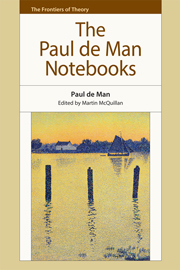Book contents
- Frontmatter
- Contents
- Series Editor's Preface
- Acknowledgements
- Dedication
- Introduction: ‘The Unimaginable Touch of Time’: The Public and Private in the Notebooks of Paul de Man
- PART I Texts
- PART II Translations
- PART III Teaching
- 17 Field of Comparative Literature: Analysis of Needs (1967)
- 18 The Comparative Literature Program at Rutgers University: A Report
- 19 Comparative Literature 816a: Hegel and English Romanticism
- 20 Comparative Literature 816a: Hegel and English Romanticism
- 21 Comparative Literature 817a: Aesthetic Theory from Kant to Hegel
- 22 Curriculum for Lit Z Proposal (1975)
- 23 Literature Z: Exercise II
- 24 Rhetorical Readings
- 25 Director's Report on Rhetorical Reading (1982)
- 26 Seminar on “Aesthetic Theory from Kant to Hegel”. Fall Semester, 1982
- PART IV Research
- Appendix. The Notebooks of Paul de Man 1963–83
- Bibliography
- Index of Names
23 - Literature Z: Exercise II
from PART III - Teaching
Published online by Cambridge University Press: 05 December 2014
- Frontmatter
- Contents
- Series Editor's Preface
- Acknowledgements
- Dedication
- Introduction: ‘The Unimaginable Touch of Time’: The Public and Private in the Notebooks of Paul de Man
- PART I Texts
- PART II Translations
- PART III Teaching
- 17 Field of Comparative Literature: Analysis of Needs (1967)
- 18 The Comparative Literature Program at Rutgers University: A Report
- 19 Comparative Literature 816a: Hegel and English Romanticism
- 20 Comparative Literature 816a: Hegel and English Romanticism
- 21 Comparative Literature 817a: Aesthetic Theory from Kant to Hegel
- 22 Curriculum for Lit Z Proposal (1975)
- 23 Literature Z: Exercise II
- 24 Rhetorical Readings
- 25 Director's Report on Rhetorical Reading (1982)
- 26 Seminar on “Aesthetic Theory from Kant to Hegel”. Fall Semester, 1982
- PART IV Research
- Appendix. The Notebooks of Paul de Man 1963–83
- Bibliography
- Index of Names
Summary
“Science” and “Art” in Nietzsche's Truth and Falsity in an Ultramoral Sense
In the second part of the essay Truth and Falsity (pp. 512–15), Nietzsche sets up what appears to be a contrast, a polarity, between the man of “science” and the man of “art.” By a close reading of this section, you are invited (1) to discuss the structure of this opposition and (2) to examine its implications with regard to the relative value of both activities, in themselves as well as with regard to history.
Preparation
The following guidelines are given as suggestions to assist you in organizing your thoughts. If syou find them cumbersome or obscure feel entirely free to ignore them and to follow your own inclinations.
(1) How does the opposition between “science” and “art” relate to the theory of language as figuration developed in part I of the essay in answer to such questions as “What is a word?” (p. 506) or “What is therefore truth?” (p. 508).
(2) In section II, Nietzsche seems to be using a valorized language, as if he were advocating a preference for certain mental activities over others. Note also that many of the metaphors and polarities used in section I recur in section II (consider, for instance, such figures as wake/sleep [dream]; master/slave; falling/rising; building/destroying; play/seriousness; truth/delusion, etc.). How are the value judgments that appear in section II influenced by the use of these figures? Is the influence of the figures on the value statements consistent with the theory of figuration that is propounded in the essay?
- Type
- Chapter
- Information
- The Paul de Man Notebooks , pp. 251 - 252Publisher: Edinburgh University PressPrint publication year: 2014



